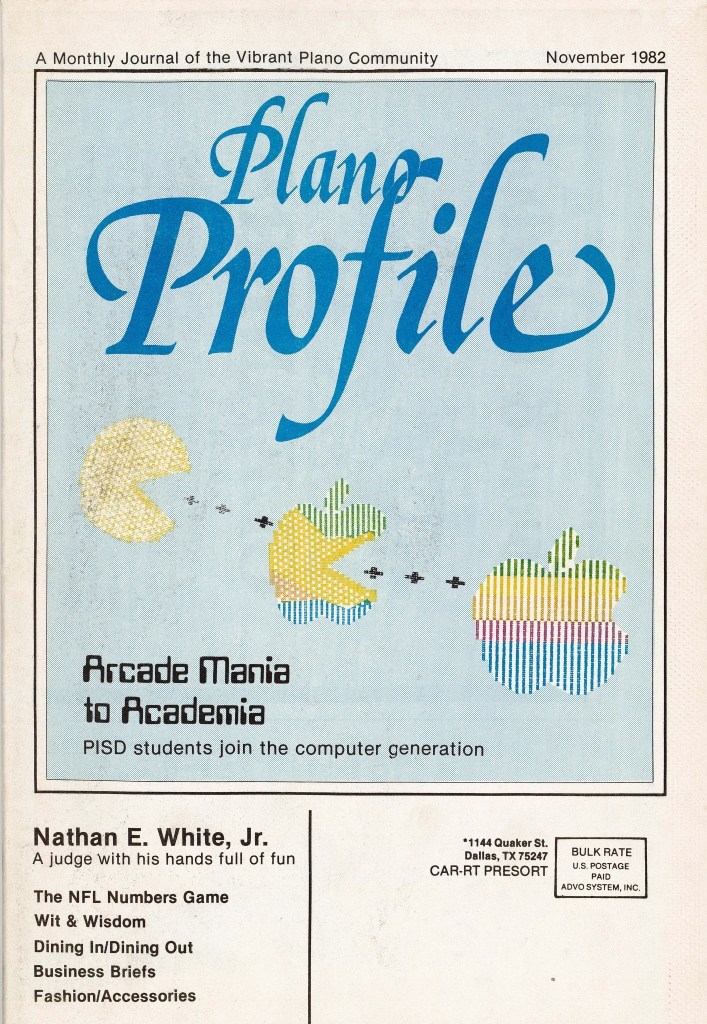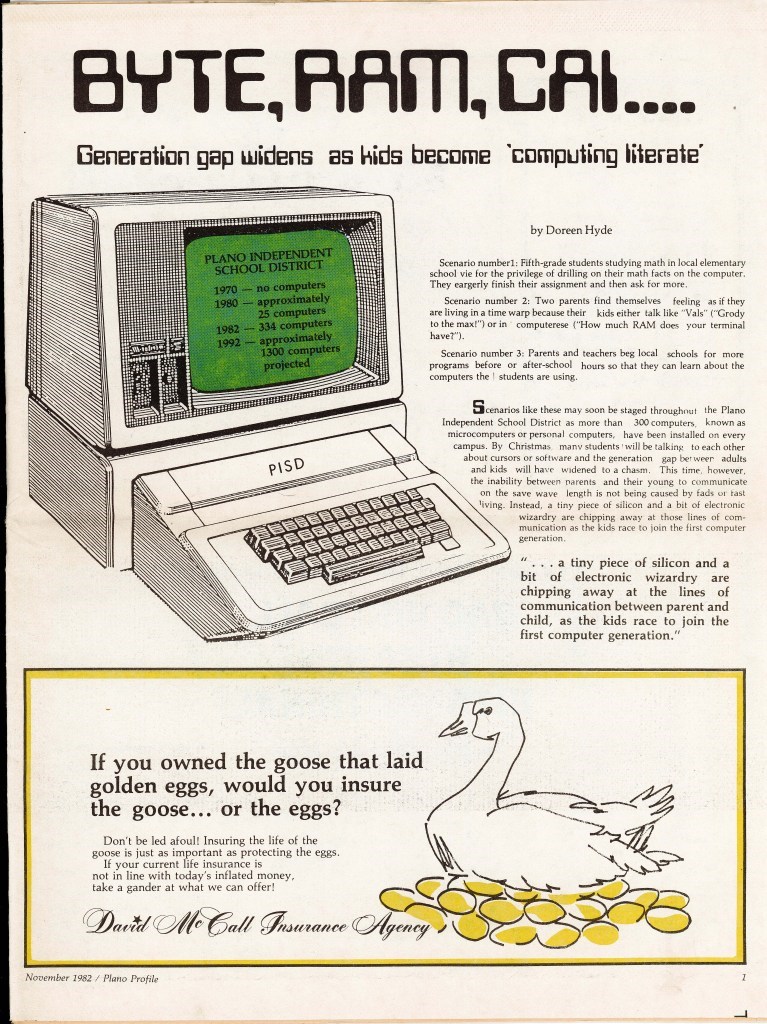Just about 40 years ago, the big tech news out of the Plano Independent School District (PISD) was the arrival of 334 personal computers for students and teachers to use. This magazine (then known as Plano Profile) wrote in its November 1982 issue that the new machines would be nothing short of a revolution in the way Plano students — at all grade levels — experienced their education.
“With the introduction of computers into every school, arcade mania is blending into academia. Video game fun and electronic education is being combined into a new field some experts are calling ‘arcademia.’”
PISD projected that by 1992, the district would have around 1,300 computers available, and Plano Profile ran a glossary to help parents prepare for that techno-centric future. It included foreign terms like “software: a general term for all computer programming” and “drive: the computer component which is used to read and write information on the storage devices such as disks or tape.”

How times change.
In the nearly half-century since the first PCs came to PISD, computers have become a central part of all our lives, and the school district in Plano has been on a mission to help its students access the most cutting-edge equipment.
“First and foremost, all of our students have access to an internet-connected device and a wide selection of what I classify as premium educational applications,” says Matt Frey, executive director for instructional technology at PISD. “We have our portrait of a graduate, and it includes some future-focused dispositions that are not academic in nature: adaptability, creative thinking, curiosity, empathy, and we want our students to be effective communicators. My refrain is always: Our kids have access to the internet all the time and that broadens the possibilities to develop those skills.”
Campus technology became more crucial to the district during the COVID-19 pandemic, as students and teachers adapted to online learning.
“We’ve had 50,000-plus Chromebooks since 2018, but we did not start sending them home until March of 2020,” Frey says. “A lot of our instructional design relied on things that weren’t digital, so when we were forced into that situation and had to test our flexibility and adaptability, we had to translate some of those nonflexible instructional experiences into an equally engaging — if not more so — digital experience. That only helped us. Our toolbox is deeper now.”
He added that the school district supports students with limited internet access at home by making personal hotspots available. Plano’s students seem to agree that the latest tech helps make their education more flexible and accessible.
"First and foremost, all of our students have access to an internet-connected device and a wide selection of what I classify as premium educational applications."
Matt Frey, executive director for instructional technology at PISD
“They’ve continued to lend out Chromebooks to anyone that needs them, at no cost, which has been great,” says Audrey Cox, a senior at Plano West Senior High School. “We’ll pull them out in class and a lot of teachers will put their slides on Google Classroom so you can follow along.”
Cox says that students are also allowed to bring their own technology from home and use it in class to help them digest the material moreeasily.
“In a lot of my courses, if I don’t feel like I’m getting enough with pen on paper, I can open my computer or start using my iPad without any sort of special permission,” she says. “I’m in anatomy and physiology, and if you see a black and white picture, you can’t see what’s going on with the heart.” But a digital diagram is easier to explore and understand.
PISD’s tech landscape isn’t just limited to laptops. The district increasingly offers specialized courses that give students access to professional-quality equipment and programs.
“Plano’s course catalog for 2022 includes a slew of offerings for STEM-related fields: aeronautical engineering, architecture, automotive engineering, agricultural technology,
and those are just some of the ones that start with the letter A,” Frey says. “We have 3D printers as an example, digital microscopes and science probeware with sensors. Technology in our schools will most likely mirror the technology found in industry,
whatever that is.”


Published in November 1982 in Plano Profile (now Local Profile)
Matt Huge, another senior at Plano West Senior High School, is taking an architecture class this year and says it’s helping him feel more prepared for lifein college and beyond.
“We use a program called AutoCAD. We’re able to design and create layouts of potential houses or whatever we decide to make in there. We can take information we make on the computer and we can send it over to a 3D printer or a laser engraver that’s on campus,” he says. “I’m going to Texas Tech in the fall and when I was there, I was able to visit their engineering labs and whatnot, and it was pretty cool.”
He said that some of the machinery he saw during that campus visit was already familiar thanks to PISD’s tech offerings.
“It’s cool that I’ve been able to learn how to use certain tools, to be able to use fancier pieces of technology,” Huge says.
Rosemary Gladden, assistant director for communications, public relations and social media at PISD, says the district also has relationships with major corporations like Boeing to support students entering STEM fields. At an event in April, Boeing announced that it would provide these students with an optional mentorship during their first year of college.
Cox agrees that campus tech has contributed to her education and helped her feel more prepared for life after high school, and she added that using school resources isn’t just limited to what she does in the classroom.
“I’m in student congress so we use the technology that graphic design uses to create the prom tickets or stuff like that,” she says.
In some cases, Plano’s current students may start using some technologies in the classroom even before recent graduates.
“My older brother is an engineer at A&M,” Cox says. “I told him I was using my mom’s iPad, so he went out and bought himself one.” Now he follows his sister’s lead in digitally taking notes and annotating his instructor’s presentations.
While Frey says PISD is doing a lot to make the latest technology available to today’s students, he acknowledges that there are always new developments on the horizon that could further alter the district’s tech landscape.
“We don’t have a full-fledged, for example, drone piloting program. I bet that’s one of the next things we do,” he says. “Kids in other districts are graduating with drone pilot licenses and they can immediately find gainful employment with those skills.”
For the Plano Profile readers of 1982, who may have seen computers as “complex machines over which they have no control … which can balk and break down, just like cars or refrigerators,” a drone piloting program or on-campus laser engraver would probably sound about as fanciful as a teleportation machine still does to us in 2022. But isn’t that kind of the point? School, after all, is meant to prepare students for the real world.
“We’re going to build the environments and experiences best suited to making that happen,” Frey says, no matter what novel devices the future may bring.




![Top 5 Reads Of The Week [March 24-28]](https://www.vmcdn.ca/f/files/localprofile/images/news/prosperisd.jpg;w=120;h=80;mode=crop)